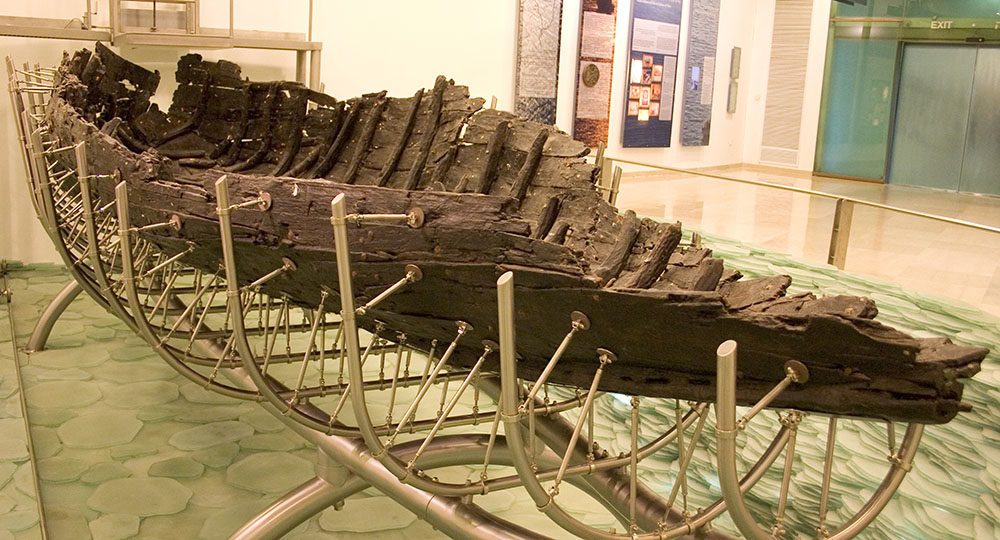The Jesus Boat
Bedlam broke out among the Ultra-Orthodox Jews of Tiberias. The fracas was over the renewed potential for Christian missionary activities around the Sea of Galilee. The culprit for this hullabaloo was the front-page headline, “The Boat of Jesus Has Been Found!”
The drought of 1985 and 1986 was severe in Israel. The water level on the lake shrank, exposing huge expanses of the lake bed. Two kibbutzniks (people who live on a communal Israeli settlement called a kibbutz), while walking leisurely along the shore’s edge, accidentally discovered the hull of a 2,000 year-old boat.
This was the first time the lake had yielded such an extraordinary treasure, soon dubbed the “Galilee Boat” and the “Jesus Boat.” While detailed studies are yet to be published, general observations have been helpful in understanding the boat’s ancient construction and seafaring capabilities on the Sea of Galilee during the time of Christ.
Extracting the hull intact from its age-old seabed of mud was a new challenge for archaeologists. The wood timbers, thoroughly waterlogged, had the consistency of wet cardboard. Any quick evaporation of its water would cause the boat to dehydrate and disintegrate. A cloth canopy was erected to block the sunlight, and water had to be constantly sprayed over the hull as volunteers carefully removed the mud. Haste was necessary due to the unexpected rainfall raising the tide and threatening to deluge the site.
A novel method was employed to move the boat. The structure was strengthened inside and out with a fiberglass/polyester resin frame molded to its shape.
The craft was then wrapped in a thin plastic sheeting and sprayed with polyurethane foam, creating a protective cocoon. Water was then pumped into the excavation pit, and a channel was dug, which permitted the boat to float into the lake. The artifact was then taken to Yigal Allan Museum at Kibbutz Ginnosar, located on the northwestern shore of the lake. There it was hoisted by crane into an empty conservation tank, and the foam was painstakingly removed. The concrete pool was then filled with a synthetic wax called polyethylene glycol, a substance that, over a period of a few years, will penetrate deep into the wood to prevent its deterioration. Eventually the hull will be taken out of this murky solution and exhibited.
The boat measures 26 1/2 feet long, 7 1/2 feet wide, and 4 1/2 feet high. According to nautical experts, it shows evidence of having a large stern platform ideal for fishing, primarily catching shoals of fish with a long net called a Sagene. It could also have served to transport goods and passengers. To determine its age, consideration was given to the construction technique, the objects found in and around the boat, and carbon-14 analysis. The estimated date is between 120 BC and AD 40. This would cover the period of Jesus’ lakeside ministry.
Did Jesus use this boat? No one is advancing that association with certainty. The general opinion is that it is of the same class as the boats referred to in the Gospels. It can be said with certainty that it is simply a tangible illustration that gives some insight into the momentous incidents in Jesus’ life on the Sea of Galilee.
This is probably the kind of craft that James and John were aboard, tending to their nets, when Jesus called them to follow Him (Mk. 1:19–20). The measurements are suitable to accommodate large groups, such as Jesus and His disciples (cp. Jn. 6:15–21). It could well have been a similar vessel in which Jesus slept in the stern during a great windstorm (Mk. 4:38). He could well have stood on the stern platform when He displayed His deity by commanding the tempestuous wind and sea to be muzzled (Mk. 4:39–41).
No doubt this once stuck-in-the-mud wreck is stirring the imaginations of many people. Despite the ultra-religious uproar, the Ministry of Tourism is hoping that their ancient boat will continue to draw more pilgrims to Israel, even if the lure is its dubious “Jesus connection.”








